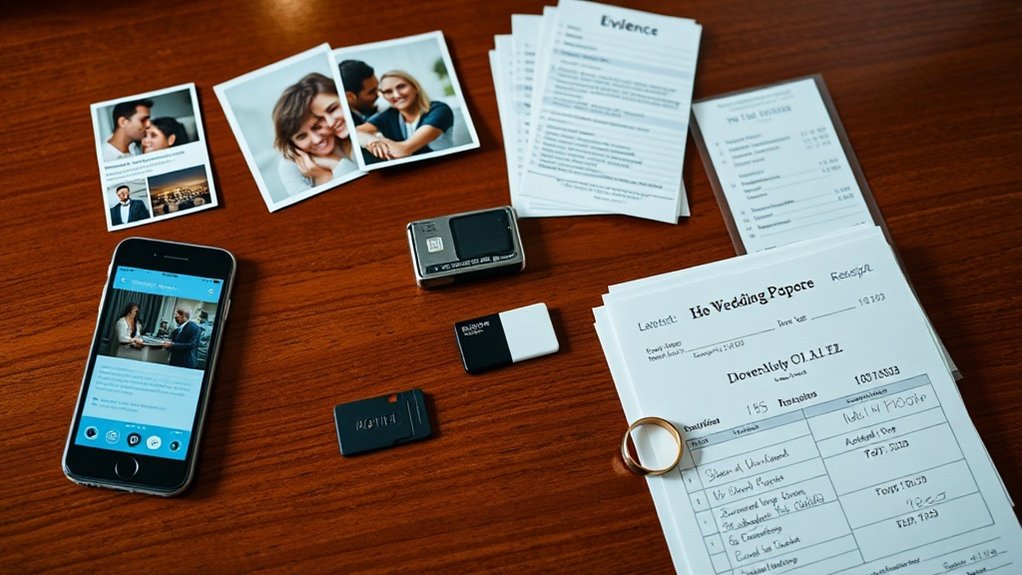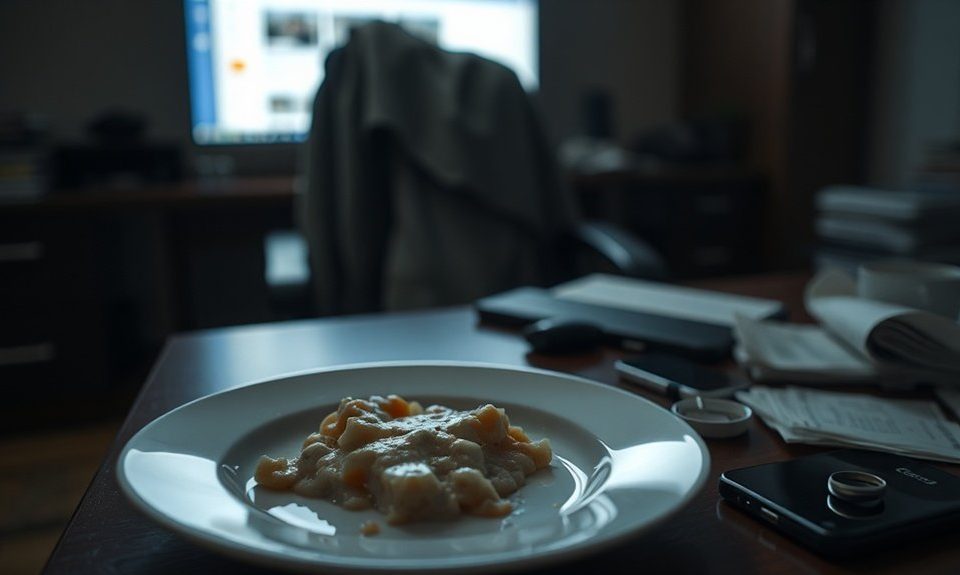Courts accept seven primary types of cheating evidence: digital communications including text messages and emails with proper authentication, financial records showing unexplained expenses and suspicious transactions, photographic and video documentation with verified timestamps, credible third-party witness testimony based on direct observation, hotel records and travel documentation creating undeniable paper trails, professional surveillance reports from licensed investigators, and social media activity including dating profiles and location discrepancies. Each evidence type requires specific collection methods and legal standards to guarantee admissibility while respecting privacy boundaries and ethical considerations that determine courtroom success.
Key Takeaways
- Digital communications like text messages and emails require proper authentication with metadata and timestamps to be admissible evidence.
- Financial records showing unexplained expenses, cash withdrawals, and suspicious transactions provide reliable timestamped proof courts readily accept.
- Photographic and video documentation offers direct visual proof but must maintain chain of custody and verify no digital manipulation occurred.
- Third-party witness testimony based on direct observation carries weight when consistent across depositions and aligned with other evidence.
- Hotel records and travel documentation create undeniable paper trails showing deliberate planning and concealment of infidelity actions.
Digital Communications and Electronic Records

Digital communications and electronic records have revolutionized how infidelity evidence manifests in modern divorce proceedings. Text message logs serve as contemporaneous documentation of intimate conversations, emotional connections, and arranged meetings between spouses and third parties. Email correspondence often reveals prolonged romantic relationships, financial arrangements, or explicit admissions of extramarital affairs.
Courts generally accept properly authenticated digital evidence, provided it meets established evidentiary standards. Screenshots must demonstrate metadata, timestamps, and sender verification to establish authenticity. Chain of custody becomes essential when preserving electronic communications. However, obtaining such evidence requires careful legal consideration. Accessing a spouse’s private communications without consent may violate privacy laws or result in illegally obtained evidence being excluded from proceedings. Consulting with qualified legal counsel guarantees compliance with jurisdictional requirements while protecting legitimate interests. Additionally, emotional validation arises from gathering concrete evidence before confrontation, particularly concerning signs of emotional disconnection.
Financial Transaction Evidence and Unexplained Expenses
How can financial records reveal patterns of infidelity when verbal admissions and digital communications remain elusive? Financial transaction evidence provides compelling courtroom documentation of suspicious activities. Bank statements frequently expose unexplained cash withdrawals, hotel charges, restaurant expenses for two, or unusual spending patterns coinciding with suspected affair periods. Credit card receipts offer detailed transaction histories, including dates, locations, and merchant categories that contradict stated whereabouts or typical behavior.
Courts recognize financial evidence as particularly reliable since transactions create permanent, timestamped records difficult to fabricate or deny. Attorneys often subpoena financial institutions directly, ensuring authenticity. Unexplained gifts, jewelry purchases, or recurring payments to unfamiliar recipients strengthen infidelity claims considerably. Furthermore, investigators can identify hidden assets and financial discrepancies that may support claims of infidelity. However, legal counsel must establish clear connections between financial anomalies and extramarital conduct, demonstrating patterns rather than isolated incidents to maximize courtroom impact.
Photographic and Video Documentation
While financial records provide circumstantial evidence of infidelity, photographic and video documentation offers direct visual proof that courts find exceptionally persuasive. These materials must demonstrate clear misconduct while maintaining photo authenticity and proper video analysis standards to withstand legal scrutiny.
Courts evaluate visual evidence based on several critical factors:
- Timestamp verification – Metadata confirming when images or videos were captured
- Location authentication – GPS coordinates or recognizable landmarks establishing where evidence was obtained
- Chain of custody documentation – Proper handling and storage records from capture to courtroom
- Technical integrity assessment – Professional analysis confirming no digital manipulation or editing occurred
- Legal acquisition methods – Evidence gathered through lawful means without privacy violations
Professional forensic examination guarantees visual documentation meets admissibility standards while protecting both parties’ legal rights throughout proceedings. Moreover, investigators must also balance privacy rights of residents with their investigative needs to ensure legality in evidence collection.
Witness Testimony From Third Parties

Third-party witness testimony serves as one of the most compelling forms of evidence in infidelity cases, as these individuals provide firsthand accounts of observed misconduct without the emotional bias that typically affects primary parties.
Courts value eyewitness accounts from friends, family members, coworkers, or acquaintances who directly observed suspicious behavior or inappropriate relationships. These witnesses can testify about specific incidents, conversations, or patterns of conduct they personally witnessed.
However, anecdotal testimonies must meet legal standards for admissibility. Witnesses cannot testify about hearsay or secondhand information. Their accounts must be based on direct observation and personal knowledge. Additionally, courts scrutinize witness credibility, examining potential motives, relationships to the parties, and consistency in their statements across depositions and trial testimony. This process is vital to ensure that evidence is foundational to the case, including any gathered through child custody surveillance.
Hotel Records and Travel Documentation
Hotel records and travel documentation provide concrete, objective evidence that courts often find more reliable than subjective witness accounts. These documents create an undeniable paper trail of movements and accommodations that can establish patterns of deception or corroborate suspected infidelity.
Legal professionals consider travel-related evidence particularly compelling because it demonstrates deliberate planning and concealment. Hotel check ins require identification verification, creating timestamped records that are difficult to dispute. Travel itineraries reveal coordination between parties and establish opportunity for intimate encounters.
- Credit card statements showing hotel charges in unexpected locations
- Airline boarding passes with destinations concealed from spouse
- Hotel loyalty program records indicating frequent visits to specific properties
- Rental car agreements during suspicious timeframes
- Expense reports contradicting claimed business travel purposes
Additionally, systematic documentation of cash flows related to these travel expenses can uncover unreported earnings that may contribute to infidelity suspicions.
Professional Surveillance and Private Investigator Reports
Licensed private investigators provide courts with professionally documented surveillance evidence that meets strict legal standards for admissibility and credibility. Their thorough reports include timestamped photographs, detailed observation logs, and witness statements that establish patterns of deceptive behavior. Professional surveillance techniques encompass digital monitoring, physical observation, and background verification while maintaining strict adherence to privacy laws.
Investigator qualifications typically include state licensing, law enforcement experience, and specialized training in evidence collection procedures. Courts value their testimony because investigators understand chain of custody requirements and proper documentation protocols. Their reports must demonstrate that surveillance was conducted legally, without trespassing or violating restraining orders. This professional approach guarantees evidence withstands legal scrutiny and cross-examination, providing compelling documentation of infidelity when personal relationships require definitive proof for divorce proceedings.
Social Media Activity and Online Dating Profiles

While traditional surveillance methods remain valuable, digital evidence from social media platforms and dating applications has become increasingly significant in documenting extramarital affairs. Courts increasingly recognize digital footprints as legitimate evidence when properly obtained and authenticated. Social media patterns revealing secretive communications, location check-ins, and relationship status changes can establish timelines and behavioral shifts. Dating app behavior, including active profiles and messaging activities, provides concrete proof of intent to engage in extramarital relationships.
Key digital evidence sources include:
- Screenshots of dating profiles with recent activity timestamps
- Direct messages and private communications between parties
- Location-based social media posts contradicting stated whereabouts
- Changes in relationship status or removal of spouse references
- Photo metadata revealing dates, times, and geographical coordinates
Understanding and abiding by legal restrictions guarantees admissibility while respecting privacy boundaries.
Frequently Asked Questions
Can DNA Evidence From Clothing or Personal Items Be Used in Adultery Cases?
DNA evidence from clothing or personal items can potentially be used in adultery cases, though courts vary in acceptance. Clothing analysis may reveal biological material indicating intimate contact with third parties. However, legal professionals must consider DNA contamination risks that could compromise evidence integrity. Obtaining such evidence requires careful adherence to ethical boundaries and proper chain of custody procedures to guarantee admissibility in proceedings.
Are Polygraph Test Results Admissible as Evidence of Cheating in Court Proceedings?
Polygraph test results are generally inadmissible in most court proceedings due to concerns about polygraph accuracy and evidence reliability. Courts typically exclude these tests because they lack scientific consensus regarding their precision in detecting deception. While some jurisdictions may allow polygraph results under specific circumstances or by mutual agreement, parties seeking to prove infidelity should focus on more legally accepted forms of evidence with established reliability standards.
Can GPS Tracking Devices Be Legally Installed on a Spouse’s Vehicle?
GPS tracking device installation on a spouse’s vehicle requires careful consideration of spousal privacy rights and local tracking laws. Generally, if both spouses own the vehicle jointly, installation may be legally permissible. However, tracking laws vary markedly by jurisdiction, and ethical boundaries suggest obtaining consent whenever possible. Installing devices on solely-owned vehicles without permission typically violates privacy expectations and may constitute illegal surveillance, potentially making evidence inadmissible.
What Statute of Limitations Applies to Filing Adultery-Related Legal Claims?
Adultery claims timeline varies greatly by jurisdiction and claim type. In fault-based divorce proceedings, most states impose one to three-year limitations from discovery of the affair. For alienation of affection or criminal conversation claims, timelines typically range from one to six years. This legal implications overview emphasizes that statutes differ considerably between jurisdictions, making immediate consultation with qualified family law attorneys essential for protecting one’s rights within applicable deadlines.
Are Recorded Phone Conversations Admissible Without the Other Party’s Consent?
Recorded phone conversations without consent face strict admissibility limitations due to varying state privacy laws. One-party consent states permit recording when the recorder participates in the conversation, while two-party consent jurisdictions require all parties’ agreement. Unauthorized phone surveillance typically violates wiretapping statutes and constitutional protections. Courts generally exclude illegally obtained recordings, and such activities may result in criminal charges and civil liability for the recording party.
Conclusion
Gathering admissible evidence of infidelity requires careful attention to legal procedures and constitutional protections. While multiple forms of documentation can support claims in court proceedings, individuals must guarantee all evidence collection complies with privacy laws and court admissibility standards. Professional legal counsel should be consulted before pursuing any evidence-gathering activities to avoid potential violations of wiretapping statutes, harassment laws, or privacy rights that could render evidence inadmissible or create legal liability.
Let Stillinger Investigations, Inc. help you navigate this complex process. Our experienced team understands the legal requirements for evidence collection and can assist you in gathering admissible proof while protecting your interests.
Stillinger Investigations, Inc.
170 Meeting St, Charleston, SC 29401
843-212-1338







